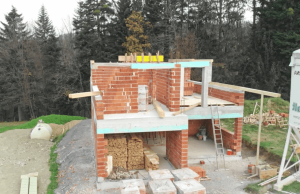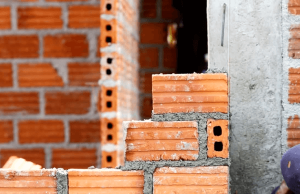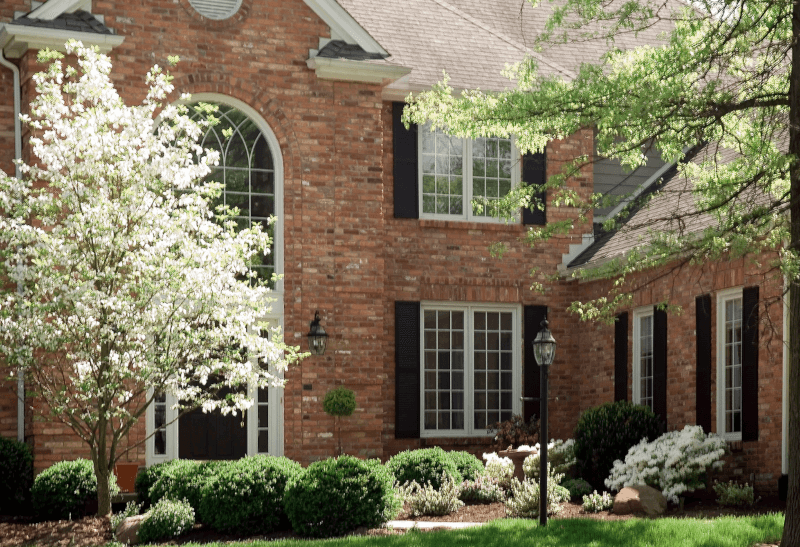Converting the façade of your house can seem like an enormous task. It certainly is one you should consider for a long time before starting any work. The first question to consider is how much it’s going to cost to convert a house to brick.
Converting an average 800-1500 square foot house to brick can cost anywhere between €3,200 and €20,000. There are different factors that will affect this cost, such as house preparation, labour costs, and building materials. On average, prepare to pay at least €6,000 to convert your house to brick.
There are many reasons you might want to consider converting your house to brick. But you should always prepare yourself for the costs attached. Read on to find out more.
How much would it cost to brick my house?
The cost of converting your house to brick will depend on a lot of factors. Let’s firstly look at the rough estimates of the cost per square foot. You can scale this to the size of your home.
For a real, solid brick conversion, the cost will be at least €8 per square foot and could reach as much as €17. Where your build sits in this range will depend on the kind of brick, and how accessible your home is for the conversion. For example, if your house sits on a steep incline, transporting materials and securing them will require extra steps in the labour process. This, and other similar factors, are going to put a higher cost on the labour, which will naturally be passed on to you.
The other choice, rather than doing a solid brick conversion, is to use brick veneer. The cost of converting your house to brick using brick veneer will be much lower. Brick veneer can come in around €4 and stretch up to €10 per square foot.
So, at the lower end of the pricing scale, you’re going to be paying at least €3,200 for a brick veneer conversion of your house. You do need to factor in the cost of labour and transportation of materials. This will add to the cost, most likely putting the lower cost of converting your house to brick, closer to €4,200. This is a ball-park figure and only a starting range. As we mentioned, there are many factors that influence the cost, which is why talking to a contractor is always recommended.
If you decide you want to convert your house to brick by yourself, you will need to consider bricklayer tools costs.
What is the process of converting a house to brick?
 To convert a house to brick, the first thing you’ll need to do is remove any existing siding. Start from the top of the external walls and make your way down. You can use a zip tool to disconnect the siding panels.
To convert a house to brick, the first thing you’ll need to do is remove any existing siding. Start from the top of the external walls and make your way down. You can use a zip tool to disconnect the siding panels.
Then, you will need to complete some prep work. You’re going to need a considerably stronger foundation with brick. If your house does not already have a moisture wrap layer, you’ll need to cover the wall with felt paper to protect against moisture.
To start laying the wall, you’ll need to use an angle iron to act as a ledge and begin the foundation. Place the angle iron at the base of the existing wall and determine how much you’ll need—then cut the angle iron to size. Mark and drill the holes in the foundation with the iron.
With lag shields in the holes, you can now lay the first row of brick. Ensure the first brick is lined up with the edge of the angle iron. Press the brick into the mortar and apply another layer on the smaller face where the next brick will sit. Continue laying bricks, always checking that it is level and plumb. You can use bricklaying profiles to help.
Converting a house to brick can take a little while. So, it’s important to make sure that preventative measures are taken to stop moisture from getting trapped between the wall and the bricks. A method to help prevent this is to create weep holes.
Attach mason blocks at either end of a wall. With a line tied from one block to the other, build the leads to ensure that your corners are straight and aligned. Once you’ve finished laying the first course, install brick ties to reinforce, and then finally build the wall up high.
Can you convert a house to brick yourself?
You can convert a house to brick by yourself or with the help of friends and family. It can be a lengthy process though, especially if you are new to bricklaying. But it isn’t impossible. Many people like to undertake these renovation tasks themselves to save some money on labour costs.
But you should consider how much you are willing to trust your own bricklaying abilities. Bricklayers perform an incredibly precise job using professional bricklaying tools. Correctly using alignments and levels while bricklaying is a challenging task. If you don’t do it correctly, your wall will be misaligned and becomes a danger to the structure of the house.
If you do have bricklaying experience, you could save quite a bit of money by choosing to convert your house to brick yourself. But without experience under your belt, we strongly suggest contacting and hiring contractors. This way you can ensure your home will be protected during and after the conversion. Also, your house will be professionally converted to brick.
Can you replace siding with real brick?
Existing siding can be replaced with brick on your house. You can also use brick siding or brick veneer. Real stone brick provides a more robust siding that will provide more protection for your house against the elements.
You will need a stronger foundation for brick siding compared to any previous siding on your house. This is a replacement that you can complete yourself but is a big task. You should be sure to seek plenty of professional advice before deciding if you will convert your house siding to brick yourself.
Does brick increase a home’s value?
Converting your house to brick can increase the value of your house if the job is completed to a high professional standard. Whether it is solid brick or brick veneer, more protection will often be provided for the house which increases the value. Brick also can increase the street appeal of your house which is another factor evaluated in your house value.
However, one thing to consider is that brick may not always increase your house value. If converting your house to brick doesn’t add many more benefits to the house, such as insulation and protection, it’s possible the value won’t increase.
That being said though, in some places brick homes sell on average for as much as 6% more than other houses. This might not seem like a huge leap, but considering the prices of homes, this can make a huge difference.
Brick requires less maintenance, has a longer lifespan, and often are more aesthetically pleasing than other materials. While it isn’t absolutely guaranteed to increase your home’s value, it certainly stands a good chance of doing so.
Converting your house to brick definitely has a lot of potential benefits, then. It can increase the value and, depending on the material your house was previously sided by, it can make it warmer and more energy efficient.
Want to learn more about brick homes? Check out our other Paragon Tools resources. We cover topics such as ‘is brick a good insulator?’ For quality bricklaying and masonry tools, jump onto our Paragon Tools products page. Looking for more advice? Feel free to give us a call! Contact Paul today at 0871618836



